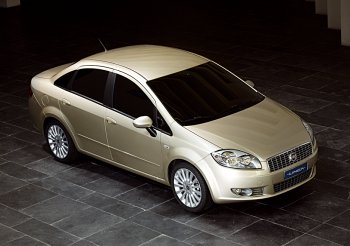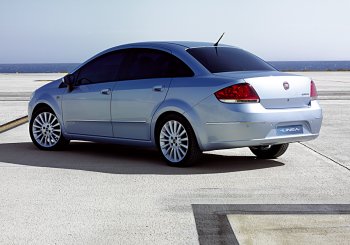|
ENGINES
|
|
The Fiat Linea
offers a comprehensive range of excellent engines that
feature state-of-the-art engineering and generous
performance. The range comprises a Multijet turbodiesel
engine (1.3 16v delivering 90 bhp) and two petrol engines: a
77 bhp 1.4 16v, and a 120 bhp 1.4 16v turbocharged engine
from the new T-JET family (which will be available after the
launch).
Each engine offers different advantages, all of which are
exploited in full by being combined with 5-speed gearboxes,
and they stand out for their generosity, their sparkling
character or their excellent performance and sophisticated
technology. But all the engines are extremely reliable and
environment-friendly.
All the engines mounted on the Fiat Linea are manufactured
by Fiat Powertrain Technologies, the Group’s new sector. FPT
draws together all the activities in the fields of
innovation, research, design and manufacture related to
engines and gearboxes for all types of applications: from
cars to commercial vehicles, boats and agricultural
machinery. With approximately 19,000 employees, 17 plants
and 10 research centres in eight different countries, the
Sector is one of the world’s most important organisations in
its field. At FPT, approximately 3000 highly specialised
technicians focus on the development and engineering of
innovative technologies. More than 40 patents are filed each
year, confirming the quality and seriousness of this
commitment, and making FPT a huge centre of technological
excellence and constant innovation.
The 120 bhp 1.4 16v T-JET
The new family of T-JET turbocharged petrol engines, which
made its debut on the Bravo, will be available on the Fiat
Linea, featuring outstanding performance, prompt response to
the accelerator, low consumption, constructional simplicity,
sturdiness and reliability.
Available after the launch, the 1.4 16v turbo engine
delivers 90 kW (120 bhp) at 5000 rpm and peak torque of 194
Nm at 1750 rpm. The engine is very elastic, requiring fewer
gear changes, for an enjoyable, relaxed driving style, but
it will respond assertively if the driver puts his foot
down. This is one effect of the low inertia of the
turboblower, which makes it possible to obtain top
performance by acting on the accelerator, and there are none
of the annoying delays typical of this type of engine. The
result is outstanding sportiness combined with fuel economy.
The outstanding reliability of the engines is guaranteed by
the hundreds of thousands of kilometres driven by prototypes
during the development stage, in addition to thousands of
hours of static and dynamic tests on the bench. The first
maintenance is scheduled after 30,000 km, and there is no
need for any intermediate servicing. The oil/water heat
exchange guarantees these results. The oil filter is of the
environment-friendly type.
The computerised engine control system manages all the
functions using sophisticated calculation algorithms. The
accelerator control is of the ‘drive-by-wire’ type, without
mechanical connections, so that the driver can obtain the
relaxed or sporty response he wants from the engine, without
wasting energy.
These excellent results have been obtained by painstaking
design and development of all the engine components,
demanding over 120,000 hours of activity. State-of-the-art
computer-assisted design and calculation systems were used,
making it possible to simulate the greatest stress caused by
the turboblower. All the major components have been
re-designed, so that we could describe the engine as
completely new. Particular attention was paid to fluid
dynamics and combustion, to minimise energy losses and to
obtain top performance and low consumption, and the results
were guaranteed by sophisticated experimental analysis.
The 77 bhp 1.4 Fire 8v
This new engine has a capacity of 1368 cc, and 4 cylinders
in line, with a bore of 72 mm and stroke of 84 mm. There are
four valves per cylinder, activated directly by 2 overhead
camshafts. The engine was developed paying particular
attention to performance and to fuel economy, two areas in
which the Fiat Linea leads its class. The merit goes to the
volumetric efficiency which has been optimised all through
the operating range, the result of precise fluid-dynamic
development of the entire intake system and the timing. The
engine delivers 57 kW (77 bhp) at 6000 rpm, and peak torque
of 115 Nm at 3000 rpm. With this engine, the Fiat Linea has
a top speed of 165 km/h, and accelerates from 0 to 100 km/h
in 14.6 seconds. Consumption is among the best in this
class: 8.2 l/100 km in the urban cycle, 5.1 l/100 km out of
town and 6.3 l/100 km in the combined cycle.
|
 |
|
 |
|
A sparkling engine that is sparing on fuel. This has been
achieved by the adoption of an electronic throttle valve
control system known as ‘drive by wire’, and of a new high
turbulence combustion chamber, combined with continuous
variable valve timing governed by the control unit. This
innovative system allows a consistent part of the exhaust
gases (about 25%) to be ‘recirculated’ in the combustion
chamber, significantly reducing fuel consumption and exhaust
emissions when driving with a partial load. The engine also
proposes a number of features designed to reduce
consumption. For example, the timing components have been
made lighter and the valve springs are of the low load type,
to reduce friction.
Another feature peculiar to the new 77 bhp 1.4 engine are
the increased compression ratio (11:1) and the high torque
values at low speeds, characteristics that make it possible
to limit fuel consumption. This target was made possible by
the calibration of the latest generation engine control
unit, which keeps fuel consumption very low, compatible with
the demand for drivability, performance and emissions. We
should underline that the 77 bhp 1.4 Fire engine is in line
with Euro 4 legislation, with a catalytic converter
positioned in the engine bay (and welded to the exhaust
manifold flange using a new technology) which reaches very
high temperatures faster, thus reducing emissions even while
the engine is warming up. To minimise the environmental
impact, the engine also incorporates a returnless fuel
supply system, which eliminates fuel recirculation within
the tank, thus reducing vapour formation. High performance,
sparing on fuel and clean: to these winning features the 77
bhp 1.4 Fire engine also adds excellent acoustic comfort,
underlined by the adoption of a flexible flywheel which
minimises the vibration transferred from the engine to the
bodyshell.
The 90 bhp 1.3 16v Multijet
The Fiat Linea range would not be complete without the 1.3
16v Multijet engine, the smallest and most advanced second
generation direct injection Common rail diesel unit, this
time with an absolute novelty: a new version with a variable
geometry turbo. This version of the 1.3 16v Multijet
delivers 90 bhp (66 kW at 4000 rpm) and torque of 200 Nm at
1750 rpm. That is not all. With the 90 bhp 1.3 Multijet, the
Fiat Linea guarantees excellent performance: it has a top
speed of 170 km/h and accelerates from 0 to 100 km/h in 13.8
seconds. Fuel consumption is also among the best for this
segment: 6.5 l/100 km in the urban cycle, 4.0 l/100 km out
of town and 4.9 l/100 km in the combined cycle.
In addition to the different turbo, other changes have been
made to the new engine. The combustion system has been
modified, increasing the permeability of the inlet and
exhaust manifolds, reducing the turbulence in the combustion
chamber and consequently modifying the geometry and the
compression ratio from 18:1 to 17.6:1. The emissions control
system envisages an EGR valve with electrical activation,
managed directly by the engine control system, a heat
exchanger to cool the recirculating exhaust gases (EGR) and
a close coupled catalytic converter. This guarantees that
the car meets the EEC STAGE 4 emissions targets.
The 90 bhp 1.3 16v Multijet is a straight-4 engine with a
capacity of 1248 cc, a bore of 69.6 mm and a ‘long’ stroke
of 82 mm. There are four valves per cylinder, governed
directly by a twin overhead camshaft via rocker fingers with
rollers. That is not all. The 1.3 Multijet 16v is a
miniature masterpiece: ‘dressed’ with all its accessories,
it weighs just 130 kg, it is small, just 50 cm long and 65
cm tall, and the component layout was designed to take up as
little space as possible. Designed by criteria of maximum
rationality, efficiency and reliability, the engine
guarantees excellent efficiency and is practically ‘for
life’: it was designed to travel 250,000 km without needing
any maintenance to the mechanical components. Oil change
intervals have also been extended, from 20,000 to 30,000 km,
and the 1.3 Multijet 16v uses a low viscosity oil, which
means fuel economy and more respect for the environment.
The compact, sophisticated engine is also
environment-friendly, and it meets the Euro 4 emissions
limits even without a particulate trap. The 90 bhp 1.3
Multijet 16v therefore represents a technological leap
forward which, for the customer, translates into lower
consumption and emissions, without even taking into
consideration the reduction in noise (due to the multiple
injections), the increase in comfort (fewer alternating
masses means less vibration), the smooth, responsive
steering (due to the extremely smooth torque delivery, which
is guaranteed by the improved combustion control), the
elasticity and prompt response of a diesel that resembles a
petrol engine for the vast excursion in the number of revs
(for example, you are no longer aware of the fuel ‘cut-out’
just above 4000 rpm), or the ecological elements that
enhance the diesel’s main environmental credentials
(consumption) which minimise its main defect (particulate
emissions). |
|